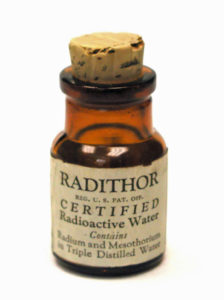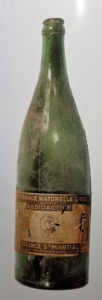
CWP Blog | CWP
Discussions with Deb: Drinks with a Kick
May 26, 2021
May 26, 2021
CWP
CWP Blog
Let’s face it. We are all looking for ways to improve our energy these days. While we are likely to reach for coffee, tea, or soda a hundred years ago people reached for radium drinks.
 Back in the 1920s Bailey Radium Laboratories manufactured a drink called Radithor which consisted of a half-ounce of distilled water to which at least 1 microcurie of Ra-226 and Ra-228 had been added. The drink was quite expensive for its time, selling for around a dollar. Luckily this priced it out of the market for most consumers of the time. Although Radithor was guaranteed to be “harmless in every respect” and sold as a drug-free energy drink, it was, of course, poisonous and caused cancer and death in some of its consumers.
Back in the 1920s Bailey Radium Laboratories manufactured a drink called Radithor which consisted of a half-ounce of distilled water to which at least 1 microcurie of Ra-226 and Ra-228 had been added. The drink was quite expensive for its time, selling for around a dollar. Luckily this priced it out of the market for most consumers of the time. Although Radithor was guaranteed to be “harmless in every respect” and sold as a drug-free energy drink, it was, of course, poisonous and caused cancer and death in some of its consumers.
 A similar product seems to have sold in France around the same time, which was advertised as Naturally Fizzy Mineral Water from a Radioactive Spring.
A similar product seems to have sold in France around the same time, which was advertised as Naturally Fizzy Mineral Water from a Radioactive Spring.
These products were on my mind recently when I stumbled across an interesting Oak Ridge document while looking for something else (isn’t this always the way?) Apparently in 1950 Oak Ridge Radiation Surveyors began checking random Coca Cola bottles to see if they were becoming contaminated before being returned to the Knoxville bottling plant for refilling. 11% of the 133 bottles surveyed showed contamination. One of the solutions offered to correct this problem was to install machines that would dispense the Coke into cups rather than using returnable bottles. I guess that would solve the problem of returnable bottles showing up at the bottling plant with radioactive contamination but I’m not sure how it would have helped protect the workers who were drinking pop with contaminated hands or in contaminated areas.
The Atomic Heritage Foundation, in partnership with National Museum of Nuclear Science and History has an interview by Isabella Karle who tells a similar but disturbingly contradictory story. Isabelle Karle was walking past the Coke machine on her way to lunch when her radiation monitor went off-scale. She quickly isolated the contamination to the Coke machine, which dispensed pop into cups. It turned out that the delivery man had forgotten to bring in a hose and funnel to refill the Coke machine. He didn’t want to go through security again so rather than go back out to the truck and get one he rummaged around in a lab until he found one he could use. This contaminated the Coke and machine. The solution to this problem was to put in a Coke machine that dispensed returnable bottles!
Back to square one.
